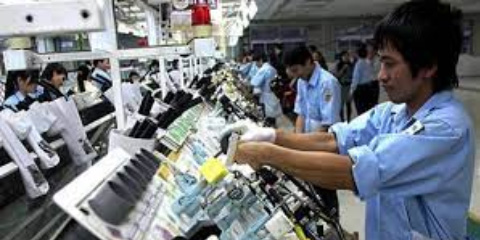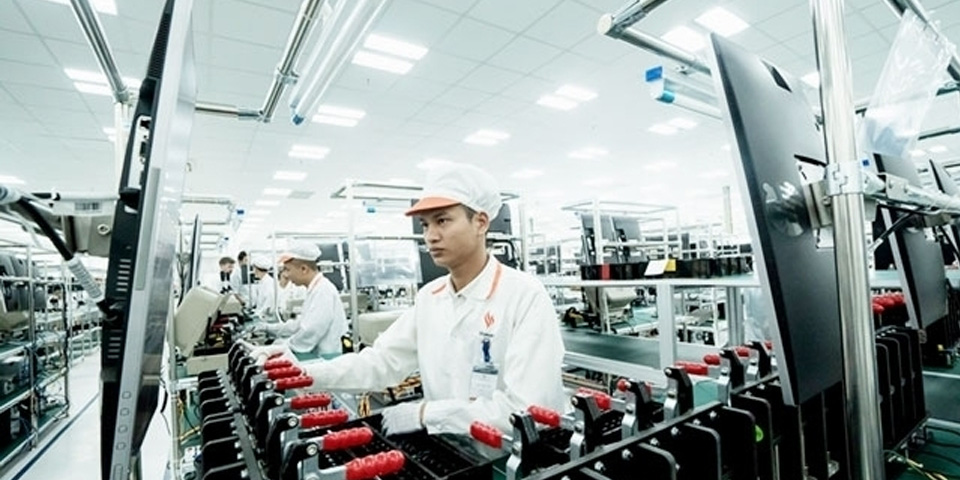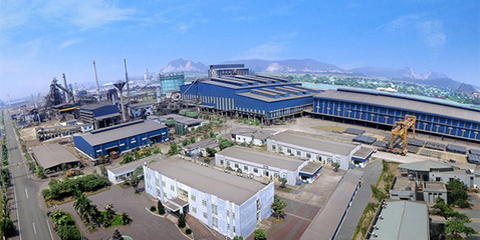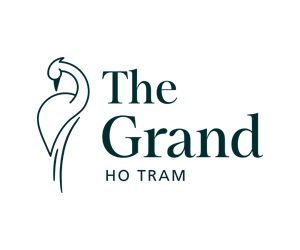Want to be in the loop?
subscribe to
our notification
Business News
ECONOMIC AND SOCIAL SITUATION IN THE FIRST QUARTER OF 2019
Economic and social situtation of Vietnam in the first months of 2019 continue to show positive changes:
Gross Domestic Products (GDP) in the first quarter achieved a quite growth of 6.79%; the macroeconomics was stable; the inflation was curbed at the lowest level in the three years 2017-2019. Investment and business environment has been improved; newly established enterprises achieved the highest increase in the last 5 years. Unemployment and underemployment rate tended to decrease. Social security was cared about. The expansion of production capacity of the economy created the momentum for Vietnams economy to develop in the next quarters of 2019.
1. Gross Domestic Products (GDP) Growth
GDP in the first quarter of 2019 was estimated to increase by 6.79% over the same period last year, though lower than the growth rate in the first quarter of 2018, it was higher than the increase rate in the first quarter of years 2011-2017[1]. In the general economic growth, the agriculture, forestry and fishery sector went up by 2.68%, contributing 4.9% to the overall growth rate; the industry and construction sector moved up by 8.63%, contributing 51.2%; the service sector expanded by 6.5%, contributing 43.9%.
In the agriculture, forestry and fishery sector, the agriculture increased by 1.84% from the same period last year, much lower than the growth rate of 3.97% in the first quarter of 2018, contributing 0.17 percentage point to the growth rate of the whole economy‘s total value added; the forestry jumped up by 4.2%, contributing only 0.03 percentage point due to the low proportion; the fishery put up by 5.1%, the highest growth rate in the first quarter of the last 9 years[2], contributing 0.14 percentage point.
In the sector of industry and construction, the industry augmented by 8.95% compared with the same period last year, contributing 3.14 percentage points to the growth rate of the whole economy‘s total value added. The main growth driver of the economy in the first quarter of 2019 is the manufacturing industry with an increase of 12.35%, though lower than the growth rate of 14.3% in the first quarter of 2018, it was higher than the increase rate in the first quarter of the years 2012-2017[3], contributing greatly to the growth rate of the total value added with 2.72 percentage points. The mining and quarrying in the first quarter of this year still saw a negative growth (a decrease of 2.2%), reducing 0.15 percentage point of the growth rate of the whole economy‘s total value added due to the decreasse of 10.3% in crude oil output and 2.4% in natural gas output. The construction in the first 3 months of this year maintained a relatively high growth rate of 6.68%, contributing 0.39 percentage point.
In the service sector, the contribution of a number of industries with a large share to the growth was as follows: Wholesale and retail sales increased by 7.82% over the same period last year, this was the industry with the largest contribution to the growth rate with 0.95 percentage point; Accommodation and catering service grew by 6.22%, contributing 0.3 percentage point; Financial, banking and insurance activities raised by 7.71%, contributing 0.36 percentage point; Real estate business moved up by 4.75%, contributing 0.24 percentage point.
In terms of economic structure in the first quarter of this year, the sector of agriculture, forestry and fishery made up 10.16%; the sector of industry and construction accounted for 35.25%; the service sector represented 44.04%; the taxes less subsidies on production took 10.55% (corresponding structure for the similar period in 2018 were 10.35%; 35.31%; 43.72%; and 10.62%).
In terms of GDP use in the first quarter of 2019, final consumption increased by 7.09% from the same period in 2018; accumulated assets grew by 6.2%; export of goods and services expanded by 6.81%; import of goods and services moved up by 8.7%.
+ Gross Domestic Products in 1st Quarter of 2019
2. Production of agriculture, forestry and fishery
a) Agriculture
As of mid-March, 3,087.2 thousand hectares (ha) of winer-spring rice were cultivated over the country, equalling 100.8% of the cultivated winer-spring rice area in the same period last year, of which localities in the North cultivated 1,088.4 thousand ha, equalling 99.6%; localities in the South cultivated 1,998.8 thousand ha, equalling 101.4%.
As of mid-March, localities nationwide cultivated 346,8 thousand ha of maize, equalling 102.9% of the cultivated maize area in the similar period last year; 62.3 thousand ha of sweet potato, equalling 98.9% of the planted sweet potato area in the same period last year; 120.8 thousand ha of peanut, equalling 98.2% of the planted peanut area in the same period last year; 14.9 thousand ha of soya, equalling 103.5% of the planted soya area in the same period last year; 520.8 thousand ha of vegetables, equalling 102.8% of the planted vegetable area in the same period last year.
Output of live weight of buffalo in the first quarter of 2019 reached 26.3 thousand tons, a rise of 1.8% over the same period last year; production of live weight of cattle recorded an estimate of 99.2 thousand tons, a rise of 2.5%; fresh cow’s milk production gained 252.2 thousand tons, an increase of 7.3%. Output of live weight of pig achieved over 1 million tons, a growth of 3.2%. Poultry production was well developed, the consumer market was stable, the total poultry population in March was estimated to increase by 6.5% over the same period last year; output of live weight of poultry in the first quarter of 2019 gained 338.3 thousand tons, an increase of 6.2%; poultry egg in the first quarter gained nearly 3.6 billion pieces, a growth of 10.6%.
b) Forestry
In the first quarter of 2019, the whole country’s concentrated planted forest area was estimated to reach 31.9 thousand ha, a rise of 1.4% compared to the same period last year; the number of separate planted trees gained 15.7 million trees, a growth of 0.5%; wood production achieved 2,714 thousand m3, a rise of 4.5%; firewood production gained 3.9 million steres, a decrease of 1.5%.
In the first three months of this year, damaged forest area was 98.7 ha, a decrease of 48.4% against the same period last year, of which the burnt forest area was 22.8 ha, a decline of 56.6%; the destroyed forest area was 75.9 ha, a decrease of 45.4%.
c) Fishery
Fishing production in the first quarter of 2019 was estimated to reach 1,466.7 thousand tons, up 4.8% over the similar period last year, of which fish achieved 1,098.7 thousand tons, up 5.1%; shrimp achieved 136.4 thousand tons, up 5.2%; other aquatic products gained 231.6 thousand tons, up 3.4%.
The whole country’s production of aquaculture in the first quarter of 2019 was estimated at 646.2 thousand tons, a rise of 4.9% from the identical period last year, of which fish reached 468.2 thousand tons, increasing by 5%; shrimp gained 101.9 thousand tons, climbing by 7.6%.
Production of fishery caught in the first quarter of 2019 achieved an estimate of 820.5 thousand tons, increasing by 4.8% against the same priod last year, of which fish gained 630.5 thousand tons, up 5.2%; shrimp recorded 34.5 thousand tons, down 1.1% (the production of sea catching reached 785.1 thousand tons, up 5%, of which fish reached 606.1 thousand tons, up 5.4%; shrimp achieved 31.6 thousand tons, down 0.9%).
+ Agricultural production as of March 15, 2019
+ Main products of animal husbandry
+ Outcome of forestry production
+ Fishing production
3. Industry
Generally, in the first quarter of 2019, the index of industrial production (IIP) increased by 9.2% over the same period in 2018, higher than the growth rate of 7.4% and 4.8% in the similar period in 2016 and 2017 respectively. Of the industries, the manufacturing continued to witness the high growth with 11.1%, contributing 8.5 percentage points to the general growth; the production and distribution of electricity put up by 9.4%, contributing 0.8 percentage point; the water supply and waste treatment grew by 8.5%, contributing 0.2 percentage point; only the mining and quarrying decreased by 2.1% , reducing 0.3 percentage point of the general growth.
Consumption index of the whole manufacturing in the first quarter of 2019 increased by 8% compared with the identical period in 2018. Inventory index of the entire manufacturing as of March 31, 2019 was estimated to increase by 15.6% over the similar period last year. Average inventory rate of the whole manufacturing in the first quarter of 2019 was 72.9%.
+ Industrial Production Index
+ Main industrial products
+ Consumption and stock indexes of the manufacturing
+ Labor employed index (LEI) for industrial enterprises
4. Operation of enterprises
a) Business registration situation
In the first quarter of this year, the whole country had 28,451 enterprises registered for new establishment with a total registered capital of 375.5 trillion dongs, a rise of 6.2% in the number of enterprise and an increase of 34.8% in the registered capital compared with the same period in 2018[4]. On average, registered capital per newly established enterprise reached 13.2 billion dongs, up 26.9%. Total registered capital added to the economy in the first quarter of this year was 1,098 trillion dongs, including 722.5 trillion dongs of enterprises increasing their capital. In addition, there were 15,050 enterprises returning to operation, a rise of 78.1% over the similar period last year, bringing the total number of newly registered enterprises and re-operated enterprises to over 43.5 thousand enterprises. Total number of registered employees of the newly established enterprises in the first quarter of 2019 was 317.6 thousand persons, a rise of 40.9% against the same period last year.
The number of temporarily ceased enterprises with a certain time in the first quarter of this year was 14,761 ones, an increase of 20.8% against the identical period last year. 15,331 enterprises suspended operation waiting for dissolution procedures, of which 8,404 enterprises have their business registration certificates revoked under the 2018 data standardization program, accounting for 54.8%; the number of enterprises announced their dissolution was 3,378 enterprises, accounting for 22% and 3,549 enterprises waiting for dissolution procedures, accounting for 23.2%. The number of enterprises finished dissolution procedures in the first quarter of 2019 was 4,116 ones, an increase of 23.9% over the same period last year, of which 3,737 ones had the capital size of less than 10 billion dongs, accounting for 90.8%.
+ Number of newly registered enterprises by kinds of activity
+ Number of enterprises returned to operation
+ Number of time-limited temporarily ceased enterprises by kinds of activity
+ Number of dissolved enterprises by kinds of activity
b) Business trends of enterprises
Survey results on business trends of enterprises in the manufacturing industry in the first quarter of 2019 showed that: 33.7% of enterprises rated their business performance in the first quarter of this year better than the previous quarter; 25.8% of enterprises pointed to difficulties and 40.5% of enterprises said that their business and production situation was stable. Expected in the second quarter of 2019, 54.6% of enterprises rated the trend would be better; 10.6% of enterprises forecasted more difficulties and 34.8% of businesses thought that the business and production situation would be stable.
5. Service activities
Total estimated retail sales of consumer goods and services in the first quarter of 2019 reached 1,184.9 trillion dongs, up 12% against the same period last year, if excluding the price factor, the growth rate was 9% (it increased by 8.9% in 2018’s similar period). By kinds of economic activity, retail sales of goods in the first quarter of this year gained an estimate of 910.4 trillion dongs, accounting for 76.8% of the total and increasing by 13.4% over the similar period last year. Estimated sales of accommodation and catering services recorded 140 trillion dongs, accounting for 11.8% of the total and moving up by 9.2% from the same period last year. Sales of travelling achieved an estimate of 11.3 trillion dongs, representing 1% of the total and climbing by 12.8%. Sales of other services gained 123.2 trillion dongs, taking 10.4% of the total and expanding by 5.1%.
Passenger carriage in the first three months of the year reached an estimate of 1,237 million passengers, up 10.8% over the same period last year and 55.7 billion passengers-kilometres, up 10%. Cargo carriage achieved 412.2 million tons, up 8.6% and 78.1 billion tons-kilometres, up 6.5%.
Telecommunication sale in the first quarter of 2019 were estimated to gain 104 trillion dongs, an increase of 7.5% from the similar period last year. As of the end of March 2019, the total number of telephone subscribers was estimated to achieve 135.3 million subscribers, an increase of 4.1% over the similar period last year, of which mobile phone subscribers reached 131.1 million ones, putting up by 6.1%; the number of fixed broadband Internet subscribers was estimated at 13.9 million subscribers, an increase of 15.8%.
International visitors to Vietnam in the first quarter of 2019 reached an estimate of 4,500.1 thousand arrivals, a rise of 7% compared with the same period last year, of which visitors coming by airway gained 3,516.3 thousand arrivals, moving up by 4.5%; by road: 908.8 thousand arrivals, rising by 26.2%; by seaway: 75 thousand arrivals, a decrease of 37.4%. In the first three months of this year, visitors from Asia reached 3,390.4 thousand of arrivals, up 7.5% over the identical period last year; visitors from Europe gained 685.2 thousand arrivals, up 6.1%; visitors from the America achieved 293.5 thousand arrivals, increasing by 6.3%; visitors from Australia gained 119.3 thousand arrivals, increasing by 0.2%; visitors from Africa achieved 11.7 thousand arrivals, a growth of 5.7%.
+ Total retail sales of consumer goods and services
+ Carriage of passengers
+ Carriage of cargos
+ International visitors to Vietnam
6. Banking and insurance operations
As of March 20, 2019, total payment means increased by 2.54% over the end of 2018 (it grew by 3.23% in the same period in 2018); capital mobilization of credit organizations grew by 1.72% (it increased by 2.2% in the same period in 2018); credit growth of the economy reached 1.9% (it was 2.23% in the corresponding period in 2018).
Insurance market in the first three months of 2019 maintained the positive growth. Revenues from premiums of the whole market in the first quarter of 2019 were estimated to increase by 17% from the similar period in 2018, of which life insurance premium grew by 23%; non-life insurance premium put up by 9%.
7. Investment
Total realized social investment capital in the first quarter of 2019 at current prices achieved 359.2 trillion dongs, up 8.8% over the same period last year and equalling 32.2% of GDP, of which the State sector’s capital gained 106.8 trillion dongs, accounting for 29.7% of the total capital and increasing by 3.5% from the same period last year; the non-State sector’s capital obtained 158 trillion dongs, taking 44% and growing by 13.6%; the FDI sector’s capital reached 94.4 trillion dongs, representing 26.3% and moving up by 7.5%.
In the investment capital of the State sector, total realized investment capital under the State budget in the first quarter of 2019 reached an estimate of 50.8 trillion dongs, equalling 14.7% of the annual plan and increasing by 3.2% against the similar period in 2018 (it equalled 14% and rose by 10.3% in the same period last year), of which the capital under central management obtained 6.3 trillion dongs, equalling 13.7% of the annual plan and decreasing by 30.5%; the capital under local management achieved 44.5 trillion dongs, equalling 14.9% of the annual plan and increasing by 10.9%.
From the beginning of the year to March 20, 2019, FDI attracted 785 newly licensed projects with the total registered capital of US$ 3,821.4 million, an increase of 27% in the number of projects and 80.1% in the registered capital against the similar period in 2018. Besides, there were 279 turns of license-granted projects from previous years registered to adjust investment capital with the additional capital of US$ 1,298.4 million, a decline of 27.5% from the same period in 2018. Therefore, the total of newly registered capital and additional capital in the first three months of the year reached an estimate of US$ 5,119.8 million, increasing by 30.9% from 2018’s same period. Realized FDI capital in the first three months of 2019 was estimated at US$ 4,120 million, increasing by 6.2% over the identical period in 2018. In the first three months of 2019, there were 1,653 turns of capital contribution and share purchase of foreign investors with a total contributory value of US$ 5.69 billion, 3 times as high as that in 2018’s same period, of which 588 turns of capital contribution and share purchase increased the charter capital of enterprises with the contributed capital of US$ 4.79 billion and 1,065 turns of foreign investors bought back domestic shares without increasing charter capital with the value of US$ 0.9 billion.
Vietnam’s direct investment abroad in the first quarter of 2019 had 24 projects newly granted the Outward Investment Registration Certificate with Vietnam’s total investment capital of US$ 80.4 million; 8 projects adjusting the capital with additional capital of US$ 39.6 million. Generally, Vietnam’s total offshore investment capital (including newly granted and additional capital) in the first quarter of this year gained US$ 120 million.
+ Realized social investment capital at current prices
+ Realized investment capital under the State budget
+ Licensed FDI projects from January 01 to March 20, 2019
8. Government revenues and expenditures
Total estimated government revenues from the beginning of the year to March 15, 2019 achieved 278.6 trillion dongs, equalling 19.7% of the annual estimate, of which domestic revenues reached 221.7 trillion dongs, equalling 18.9%; collecting from crude oil gained 9.9 trillion dongs, equalling 22.3%; collecting from export-import balance obtained 47 trillion dongs, equalling 24.9%.
Total government expenditures from the beginning of the year to March 15, 2019 was estimated at 254.5 trillion dongs, equalling 15.6% of the yearly estimate, of which regular expenditures were 192.7 trillion dongs, equalling 19.3%; expenditure on development investment achieved 33.5 trillion dongs, equalling 7.8%; expenditure on interest payment was 27.7 trillion dongs, equalling 22.2%.
9. Exports and imports of goods and services
a) Exports of goods
In the first quarter of 2019, export turnover of goods was estimated to reach US$ 58.51 billion, a rise of 4.7% compared with the same period in 2018, of which the domestic economic sector achieved US$ 17.05 billion, moving up by 9.7%; the FDI sector (including crude oil) gained US$ 41.46 billion, increasing by 2.7%, accounting for 70.9%.
b) Imports of goods
Import turnover of goods in the first quarter of 2019 reached an estimate of US$ 57.98 billion, moving up by 8.9% from the same period in 2018, of which the domestic economic sector gained US$ 24.09 billion, climbing by 13.4%; the FDI sector achieved US$ 33.89 billion, jumping up by 6%.
Trade balance in the first quarter of 2019 continued to record the trade surplus of US$ 536 million, of which the domestic economic sector had trade deficit of US$ 7.04 billion; the FDI sector (including crude oil) had trade surplus of US$ 7.57 billion.
c) Exports and imports of services
Service export turnover in the first quarter of 2019 were estimated to reach US$ 4.1 billion, up 5.7% compared to the similar period in 2018, of which travel service gained US$ 3 billion (accounting for 71.2% of the total export turnover), a rise of 7.3%; transportation service achieved US$ 741 million (accounting for 17.9%), increasing by 1.5%. Estimated service import turnover in the first quarter of 2019 reached US$ 4.6 billion, putting up by 6.3% over the identical period last year, of which transportation service gained US$ 2.2 billion (accounting for 47.5% of the total import turnover), increasing by 8%; travel service attained US$ 1.4 billion (making up 31.6%), rising by 6.7%. Trade deficit of services in the first quarter of 2019 was US$ 405 million, equaling 9.8% of the service export turnover.
+ Exports
+ Imports
+ Import and export of services
10. Price indexes
a) Consumer price indexes (CPI)
Average CPI in the first quarter of 2019 increased by 2.63% compared to the the corresponding period in 2018, this is the lowest increase in the first quarter in the last 3 years[5]; CPI in March 2019 went up by 0.69% over December 2018 and 2.7% over the same period in 2018.
Core inflation in March 2019 moved down by 0.06% against the previous month and moved up by 1.84% from the same period last year. Average core inflation in the first quarter of 2019 increased by 1.83% over the similar period last year.
b) Gold price index and US dollar index
Domestic gold prices fluctuate according to world gold prices. Gold price index in March 2019 decreased by 0.49% against the previous month, increased 3.3% from December 2018 and fell by 0.3% from the same period last year.
The US dollar price index in March 2019 grew by 0.05% over the previous month, decreased by 0.44% against December 2018 and increased by 2.02% compared to the same period in 2018.
c) Producer price indexes (PPI)
Price indexes of materials, fuels used for production in the first quarter of 2019 expanded by 0.19% over the fourth quarter of 2018 and 2.60% over the same period last year ; PPI for agriculture, forestry and fishery in the first quarter of this year increased by 0.43% against the fourth quarter of 2018 and 3.60% against the same period last year; PPI for industry in the first quarter of 2019 reduced by 0.54% from the fourth quarter of 2018 and put up by 1.45% from the similar period last year; PPI for services in the first quarter of 2019 moved up by 0.79% compared to the fourth quarter of 2018 and 2.86% compared to the identical period last year.
Merchandize export price index in the first quarter of 2019 increased by 3.63% over the fourth quarter of 2018 and 2.88% over the same period last year; Merchandize import price index in the first quarter fell by 0.27% and put up by 1.06%, respectively. Merchandize term of trade[6] in the first quarter of this year moved up by 3.91% against the fourth quarter of 2018 and 1.81% from the same period last year in 2018.
+ Consumer price indexes, gold, US dollar price indexes and core inflation in March 2019
+ Producer Price Indexes
+ Price index of materials, fuels used for production
+ Transport and Warehouse Charge Index
+ Merchandize export price index
+ Merchandize import price index
+ Commodity term of trade
11. Labor and employment
The whole country’s labor force aged 15 years and above in the first quarter of 2018 was estimated at 55.4 million persons, reducing 207 thousand persons compared to the previous quarter and increasing 331.9 thousand ones compared to the same priod last year, of which male employees were 29 million ones, accounting for 52.3%; female employees were 26.4 million ones, accounting for 47.7%. The labor force aged 15 years and above in urban areas was 18.5 million persons, making up 33.3%; the labor force aged 15 years and above in rural areas was 36.9 million persons, taking 66.7%. Labor force within working age in the first quarter of 2019 was estimated at 48.8 million persons, a decrease of 96.4 thousand persons compared to the previous quarter and a rise of 444.2 thousand ones compared to the similar period last year, of which male employees were 26.6 million ones, accounting for 54.4%; female employees were 22.2 million ones, accounting for 45.6%. The labor force within working age in urban areas was 16.9 million persons, holding 34.7%; the labor force within working age in rural areas was 31.9 million persons, representing 65.3%.
The labor force aged 15 years and above employed in the first quarter of 2019 was estimated at 54.3 million persons, including 19.2 million ones working in the agriculture, forestry and fishery sector, accounting for 35.4% of the total; 15.6 million ones working in the industry and construction sector, taking 28.6%; 19.5 million ones working in the service sector, accounting for 36%.
The unemployment rate of labor force within working age in the first quarter of 2019 was 2.17%, of which this rate of urban and rural areas were 3.11% and 1.67%[7], respectively. The unemployment rate of the youth aged 15-24 in the first quarter of 2019 was estimated at 6.27%, of which this rate of urban and rural areas were 10.49% and 4.64%, respectively.
The underemployment rate of working-age laborers in the first quarter of 2019 was estimated to be 1.21%, in which it was 0.60% for the urban area; 1.53% for the rural area. Rate of workers with informal employment outside of agricultural, forestry and fishery households[8] in the first quarter of 2019 was estimated to be 54.3%, of which 45.9% was in the urban area; 61.3% was in the rural area.
+ Selected indicators on labours
+ Unemployment and underemployment rate of laborers 1st Quarter, 2019
12. People’s life and social security
According to the preliminary report from localities, in the first quarter the whole country had 28.5 thousand households suffering from food shortage, a decrease of 38.3% from the same period last year, corresponding to 105.3 thousand persons suffering from food shortage, a decline of 39.2%. To overcome this problem, from the beginning of the year, all administrative levels, sectors and organizations from central to local level supported difficult households with 1.7 thousand tons of rice.
According to the preliminary report, in the first quarter of this year, 14 million health insurance cards, free health care books/cards were donated to policy beneficiaries nationwide.
13. Education and training
According to the preliminary report, in the school-year 2018-2019, the whole country had 5,360 thousand children attending kindergartens; 8,359 thousand primary school pupils; 5,603 thousand lower secondary school pupils; 2,578 thousand pupils in upper secondary schools; and 11.7 thousand students at pedagogical intermediate schools; 44.5 thousand students at pedagogical colleges; 1,443 thousand formal university students. In the first three months of 2019, vocational training enrolled 248.8 thousand new students, of which 44.8 thousand students were enrolled for college and intermediate level; 204 thousand students were enrolled for elementary level and other vocational training programs.
14. Epidemic diseases and food poisoning
In the first three months of 2019, the whole country had over 8.5 thousand cases of hand, foot, mouth disease (1 case died); 41.9 thousand cases of hemorrhagic fever (2 cases died); 6 case of meningococcal disease; 84 cases of virus encephalitis; and 173 persons suffering from food poisoning (3 persons died).
Total number of alive HIV-infected persons over the country as of March 18, 2019 was 209.07 thousand persons and 95.8 thousand cases turned to AIDS. The number of persons died of HIV/AIDS nationwide as of above time-point was 98.2 thousand persons.
15. Traffic accidents
In the first three months of 2019, 4,030 traffic accidents occurred nationwide, including 2,148 cases of traffic accidents from less serious to become and 1,882 cases of traffic collisions, causing 1,905 deaths, 1,209 injuries and 1,932 minor injuries. Compared to the same period last year, the number of traffic accidents in the first three months of 2019 declined by 13.8% (number of traffic accidents of differently serious levels reduced by 10.4%; number of traffic collisions decreased by 17.4%); number of death fell by 11.4%; number of injuries went down by 0.9% and number of minor injuries moved down by 19.7%. On average, 45 traffic accidents occurred nationwide each day in three months, including 24 traffic accidents from less serious to become and 21 traffic collisions, causing 21 deaths and 13 injuries and 22 minor injuries.
16. Damages caused by natural calamity, environment protection, fire and explosion prevention
Natural calamity occurring in the first three months of 2019 made 8 persons died and lost, 15 persons injured, 4.9 thousand ha of rice and crops damaged, 265 houses collapsed and swept away, nearly 8 thousand houses got landslide and damaged. The total loss caused by natural disasters in the first quarter of 2019 was estimated at over 104 billion dongs.
In the first quarter of 2019, 2,378 cases of violating regulations of environment protection were found over the country, of which 2,127 cases were treated with total fine of 22 billion dongs.
Generally, in the first three months of 2019, there were 957 fire and explosion cases occurring nationwide, causing 30 deaths and 57 injuries, with an estimated damage of over 154 billion dongs.
+ Some key social and environmental indicators
GENERAL STATISTICS OFFICE
[1] GDP growth in the first quarter of the years: 5.90% in 2011; 4.75% in 2012; 4.76% in 2013; 5.06% in 2014; 6.12% in 2015; 5.48% in 2016; 5.15% in 2017; and 7.45% in 2018; and 6.79% in 2019.
[2] The growth rate of the value added of the fishery in the first quarter of the years: 2.87% in 2011; 4.06% in 2012; 2.28% in 2013; 4.72% in 2014; 3.38% in 2015; 1.90% in 2016; 3.76% in 2017; 4.96% in 2018; and 5.1% in 2019.
[3] The growth rate of the value added of the manufacturing in the first quarter of the years: 8.74% in 2012; 4.38% in 2013; 5.97% in 2014; 9.70% in 2015; 8.94% in 2016; 8.60% in 2017; 14.30% in 2018; and 12.35% in 2019.
[4] In the first quarter of 2018, the number of newly established enterprises increased by 1.2% compared with the
same period in the previous year; the registered capital grew by 2.7%; registered capital per enterprise moved up by 1.5%.
[5] The average CPI growth rate in the first quarter compared with the same period of the previous year of some years was as follows: a growth of 4.96% in 2017; an increase of 2.82% in 2018; a rise of 2.63% in 2019.
[6] The ratio of the export price index to the corresponding import price index
[7] The unemployment rate of labor force within working age in the first quarter of 2018 was 2.20%, of which it was 3.12% for the urban area and 1.74% for the rural area.
[8] Non-agricultural informal employment include those who do not work in the agriculture, forestry and fishery sector and belong to one of the following three groups: (i) employees in the formal economic sector with an absence of a labor contract or having a labor contract with a certain time without compulsory social insurance paid by their employers; family-contributing workers working in establishments belonging to the formal economic sector and members of producer’s cooperatives without compulsory social insurance; (ii) establishment owners, own-account workers, wage workers (employees) and family-contributing workers in establishments belonging to the informal economic sector; (iii) own-account workers engaged in production of goods and services for own consumption of their households and workers hired by households.
Related News

CUSTOMS BUDGET REVENUE EXPERIENCES 3% DECLINE IN Q1
Vietnam’s import and export value reached a total of US$145.59 billion in the first quarter (Q1) of 2024, marking a year-on-year growth of 18.2%. However, the customs budget revenue saw a 3% year-on-year decline, amounting to VND71,520 billion in the quarter, thereby achieving 19.1% of the full-year target.

RAPID LAW IMPLEMENTATION MAY PROPEL MARKET FORTUNES
“Investors and developers are looking forward to the implementation of the new law, which will remove obstacles for a range of projects that are struggling due to stalled procedures and lack of legality. For them, the earlier the better,” he said.

NATION URGED TO BUILD ON ECO-IP MODEL
Industrial parks (IPs) involved in an initiative that aims to help push them into the realm of being classed as eco-parks have seen improvements across a string of indicators, according to a review event in Ho Chi Minh City last week.

YEN LU INDUSTRIAL PARK: NEW DESTINATION FOR INVESTORS
Bac Giang is a destination chosen by many domestic and foreign investors thanks to its locational advantages and its most opening and favorable investment policies. Assisted by local authorities, Capella Land Joint Stock Company has effectively invested in industrial zones, especially Yen Lu Industrial Park - a new destination for investors, to contribute to the province’s success in investment attraction.

OPTIMIZING LEGAL AND REGULATORY FRAMEWORKS FOR EFFICIENT PUBLIC INVESTMENT DISBURSEMENT
According to the Ministry of Planning and Investment, a 1% increase in public investment raises GDP by 0.058%, and each VND1 disbursed stimulates an extra VND1.61 from the non-state sector. However, plan implementation often falls short at around 80% annually, despite government efforts.

NATION URGED TO BUILD ON ECO-IP MODEL
For the 2020-2024 project, three IPs were selected for the transformation including Deep C Industrial Zones in the northern city of Haiphong, AMATA City Bien Hoa in the southern province of Dong Nai, and Hiep Phuoc IP in Ho Chi Minh City. Over the last four years, the level of compliance with the international framework on eco-IPs for all pilot complexes has increased in terms of environment, economy, and management.
































